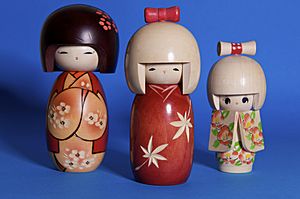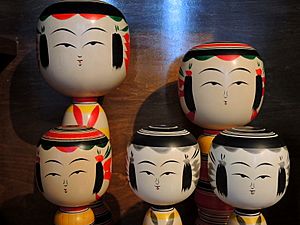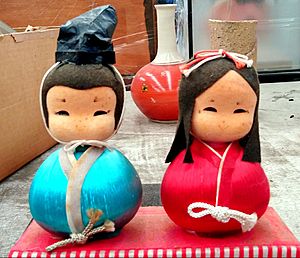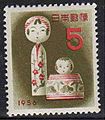Kokeshi facts for kids
Kokeshi are special wooden dolls from Japan. They don't have arms or legs, and they have been made for over 150 years. These dolls were first created as toys for children in the northeastern part of Japan, called the Tōhoku region.
Each Kokeshi doll is made by hand from wood. They have a simple body and a round head. Their faces are drawn with just a few thin lines. The doll's body often has colorful designs like flowers or rings. These designs are usually painted in red, black, and sometimes green, purple, blue, or yellow. After painting, the dolls are covered with a layer of wax to protect them.
One unique thing about Kokeshi dolls is that they don't have arms or legs. This design makes them easier for small children to hold and play with. Since the 1950s, the artists who make Kokeshi dolls usually sign their work. You can often find their signature on the bottom or sometimes on the back of the doll.
Contents
History of Kokeshi Dolls
Kokeshi dolls were first made by skilled woodworkers called kijishi. These artisans were very good at using a potter's wheel to shape wood. They started making Kokeshi dolls near the Tōgatta Onsen (hot spring) in Zaō. From there, the way to make Kokeshi dolls spread to other hot spring areas in the Tōhoku region.
It is believed that these dolls were first made a long time ago, during the middle of the Edo period (1600–1868). They were sold to people who came to visit the hot springs in northern Japan. Visitors would buy them as souvenirs or gifts.
Different Types of Kokeshi
There are two main types of Kokeshi dolls: "traditional" and "creative."
Traditional Kokeshi Dolls
Traditional Kokeshi dolls have shapes and patterns that are special to certain areas of Japan. The most common type is the Naruko variety. These dolls were first made in Miyagi Prefecture. If you visit the main street of Naruko Onsen Village, it's known as Kokeshi Street. Here, you can find many shops run by the artists who carve these dolls. There are more than 250 different styles of traditional Kokeshi dolls!
Creative Kokeshi Dolls
"Creative" Kokeshi dolls are different because the artist has complete freedom. They can choose any shape, design, or color they like. These dolls started to become popular after World War II (1945). Unlike traditional dolls, creative Kokeshi are not linked to a specific region of Japan. You can often find artists who make creative Kokeshi in bigger cities.
Wood Used for Kokeshi
The type of wood used for Kokeshi dolls can vary. Cherry wood is sometimes used because it is dark. Dogwood is chosen for its softer qualities, which makes it easier to carve. A type of Japanese maple called Itaya-kaede is also used for both traditional and creative dolls. Before the wood can be used, it is left outside to dry for one to five years. This process is called seasoning.
Kokeshi in Popular Culture
Kokeshi dolls have inspired many things in popular culture.
Nintendo's Mii Characters
Nintendo's digital characters, called "Miis," were inspired by the style of Kokeshi dolls. Players can create and customize their own Mii characters. The simple, round appearance of Miis has become a symbol for the overall look of Nintendo's gaming platforms.
Video Games and Other Dolls
In the popular PlayStation game series LittleBigPlanet, a Kokeshi doll appears in the game. Players can even get this doll and use it to create their own game levels.
The Momiji Doll also got its inspiration from the Kokeshi Doll.
Images for kids
See also
 In Spanish: Kokeshi para niños
In Spanish: Kokeshi para niños










